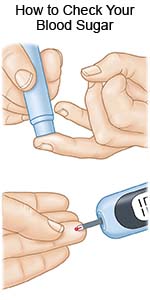WHAT YOU NEED TO KNOW: What is diabetic peripheral neuropathy (DPN)? DPN is damage to the nerves in your arms, hands, legs, and feet. DPN is most common in the legs and feet and can increase your risk for foot ulcers. Nerve pain caused by DPN can limit your mobility, and affect your quality of life. What increases my risk for DPN? - Poor blood sugar control
- High blood pressure, high cholesterol, or lack of vitamin D
- Tobacco use
What are the signs and symptoms of DPN? You may have no symptoms at all. You may have any of the following: - Increased sensitivity to touch
- Muscle weakness or problems balancing or walking
- Burning, tingling, cramping, or pain in your feet or hands
- Not able to feel hot, cold, or pressure due to loss of protective sensation (LOPS)
- Decreased muscle and fat around your feet
- Decreased movement of your ankles
- Foot redness, warmth, or calluses
How is DPN diagnosed and treated? Your healthcare provider will check your reflexes, strength, and flexibility. A 10-g monofilament test will be done. A monofilament is a device with one flexible strand that will touch the soles of your feet. Your healthcare provider may also do a pinprick, temperature, or vibration sensation test. Controlled blood sugar levels is the only treatment for DPN. Controlled blood sugar levels cannot reverse nerve damage. You may be able to prevent or delay DPN, if you have type 1 diabetes. If you have type 2 diabetes, controlled blood sugar levels may slow the progression. Your healthcare provider may give medicines to help with the nerve pain. How can I control my blood sugar levels? Keep your blood sugar levels as close to normal as possible by taking your medicines as directed. Check your blood sugar levels as often as directed. Contact your healthcare provider if your levels are higher than they should be. 
|
- Follow the meal plan that your healthcare or dietitian gave you. This meal plan can help you control your blood sugar and decrease your symptoms.
- Exercise regularly. Exercise can help keep your blood sugar level steady and help you manage your weight. Exercise for at least 30 minutes, 5 days a week. Ask your healthcare provider about the best exercise plan for you. Use caution when you exercise if you have decreased feeling in your feet.
- Maintain a healthy weight. Ask your healthcare provider how much you should weigh. A healthy weight can help you control your diabetes. Ask him to help you create a weight loss plan if you are overweight. Even a 10 to 15 pound weight loss can help you manage your blood sugar level.
- Limit alcohol. Alcohol affects your blood sugar level and can make it harder to manage your diabetes. Women should limit alcohol to 1 drink a day. Men should limit alcohol to 2 drinks a day. A drink of alcohol is 12 ounces of beer, 5 ounces of wine, or 1½ ounces of liquor.
What else can I do to prevent or manage DPN? - Care for your feet. Check your feet each day for cuts, scratches, calluses, or other wounds. Look for redness and swelling, and feel for warmth. Wear shoes that fit well. Check your shoes for rocks or other objects that can hurt your feet. Do not walk barefoot or wear shoes without socks. Wear cotton socks to help keep your feet dry.
- Do not smoke. Nicotine can worsen your symptoms and make it more difficult to manage your diabetes. Do not use e-cigarettes or smokeless tobacco in place of cigarettes or to help you quit. They still contain nicotine. Ask your healthcare provider for information if you currently smoke and need help quitting.
When should I seek immediate care? - Your legs or feet start to turn blue or black.
- You have a wound that does not heal or is red, swollen, or draining fluid.
When should I contact my healthcare provider? - You begin to have symptoms.
- Your blood sugar level is higher or lower than healthcare providers have told you it should be.
- You have redness, calluses, or sores on your feet.
- You have questions or concerns about your condition or care.
|